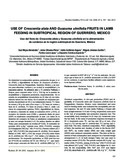| dc.rights.license | http://creativecommons.org/licenses/by-nc-sa/3.0/ve/ | |
| dc.contributor.author | Hernández, Saúl Rojas | |
| dc.contributor.author | Olivares Pérez, Jaime | |
| dc.contributor.author | Gutiérrez Segura, Isidro | |
| dc.contributor.author | Jiménez Guillén, Régulo | |
| dc.contributor.author | León López, Fortino | |
| dc.contributor.author | Córdova Izquierdo, Alejandro | |
| dc.date.accessioned | 2013-06-04T22:05:04Z | |
| dc.date.available | 2013-06-04T22:05:04Z | |
| dc.date.issued | 2013-04-30 | |
| dc.identifier.issn | 0798-2259 | |
| dc.identifier.uri | http://www.saber.ula.ve/handle/123456789/37172 | |
| dc.description.abstract | Se determinó la composición química, producción de gas in vitro
(PGIV) y digestibilidad de frutos de Guazuma ulmifolia y
Crescentia alata en Pungarabato, Guerrero, México, y se usaron
para alimentar corderos y se evaluó la aceptabilidad y la
respuesta animal. Se utilizaron seis y 15 corderos Pelibuey x
Dorper, peso corporal entre 13,9 y 15,6 kg en la prueba de
aceptabilidad y respuesta productiva, respectivamente. En el
estudio de aceptabilidad desarrollado en 22 días (d), los tratamientos
fueron los dos frutos. En el estudio de respuesta productiva
desarrollado en 55 d, los tratamientos fueron: T1: heno
de avena y 50 g de maíz (Zea mays L.) T2: heno de avena y
fruto de G. ulmifolia, T3: heno de avena y fruto C. alata. Los
datos de composición química, PGIV, digestibilidad de frutos,
el número y duración de visitas al comedero (NVC y DVC), el
consumo de materia seca (CMS) y ganancia diaria de peso
(GDP) se analizaron completamente al azar. Los datos de la
dinámica del consumo de frutos se analizaron completamente
al azar con arreglo factorial 2 x 6. En ambos diseños se utilizó
Tukey para comparación de medias (P<0,05). El contenido de
proteína (82,0 g kg–1 materia seca (MS); P<0,030), energía
(5,6 Magajoules (MJ) kg–1 MS; P<0,010) y fenoles totales (22,7
g kg–1 MS; P<0,001) fue mayor para G. ulmifolia. En la aceptabilidad
el CMS, NVC y DVC fue mayor (P<0,05) sobre frutos
de G. ulmifolia con 189, 4 g d–1, 15,5 visitas y 3,2 minutos, respectivamente.
En respuesta productiva, el CMS total fue mayor
(P<0,05) en corderos del T2 con 830,0 g–1 d–1, que representó
mayor consumo del fruto de G. ulmifolia (686,0 g–1 d–1),
lo que aumentó la GDP (81,0 g–1 d–1) de los animales. Se concluyó
que el fruto de G. ulmifolia incrementó el CMS y la GDP
en los corderos, lo que hace factible utilizarlo como suplemento
en épocas críticas. | es_VE |
| dc.language.iso | es | es_VE |
| dc.publisher | SABER-ULA | es_VE |
| dc.rights | info:eu-repo/semantics/openAccess | |
| dc.subject | Corderos | es_VE |
| dc.subject | Frutos | es_VE |
| dc.subject | G. ulmifolia | es_VE |
| dc.subject | C. alata | es_VE |
| dc.subject | Cambio de peso | es_VE |
| dc.title | Use of crescentia alata and guazuma ulmifolia fruits in lamb feeding in subtropical region of Guerrero, Mexico | es_VE |
| dc.title.alternative | Uso del fruto de crescentia alata y guazuma ulmifolia en la alimentación de corderos en la región subtropical de Guerrero, México | es_VE |
| dc.type | info:eu-repo/semantics/article | |
| dc.description.abstract1 | Chemical composition, in vitro gas production (PGIV) and digestibility
of Crescentia alata and Guazuma ulmifolia fruits in
Pungarabato, Guerrero, Mexico, were determined and were
used to feeding lambs and evaluated the acceptability and animal
response. Six and 15 male lambs Pelibuey x Dorper with
body weight between 13.9 and 15.6 kg, respectively were used
in the test of acceptability and productive response test. The
acceptability study developed in 22 days (d), treatments were
the two fruits. In the study of productive response developed in
55 d, treatments were: T1: oat hay and 50 g of corn, (Zea
mays L.) T2: oat hay and G. ulmifolia fruit, T3: oat hay and C.
alata fruit. The data, chemical composition, PGIV, digestibility
of fruits, the number and duration of visits to the feeder (NVF
and DVF), dry matter intake (DMI) and daily weight gain
(DGW) were analyzed completely random. The data on the dynamics
of fruit consumption were analyzed in a factorial design
arrangement 2 x 6. In both designs Tukey test was used to
compare means (P<0.05). The protein content (82.0 g kg–1 dry
matter (DM); P<0.030), energy (5.6 MJ kg–1 DM; P<0.010) and
total phenol (22.7 g kg–1 DM; P<0,001) was higher for G. ulmifolia.
In the acceptability DMI, NVF and DVF was higher
(P<0.05) about fruits of G. ulmifolia with 189.4 g–1 d–1, 15.5 hits
and 3.2 minutes, respectively. In productive response the DMI
total was higher (P<0.05) in lambs of T2 with 830.0 g a–1 d–1,
which represented more consumption of G. ulmifolia fruit
(686.0 g a–1 d–1), this increased DGW (81.0 g a–1 d–1) of animals.
It was concluded that the G. ulmifolia fruit increased, the
DMI and weight gain in lambs, which makes it feasible to use it
as a supplement in critical times. | es_VE |
| dc.description.colacion | 157-162 | es_VE |
| dc.description.email | saulrh@hotmail.com | es_VE |
| dc.description.frecuencia | Bimestral | |
| dc.identifier.depositolegal | 199102ZU46 | |
| dc.publisher.pais | Venezuela | es_VE |
| dc.subject.institucion | Universidad del Zulia (LUZ) | es_VE |
| dc.subject.institucion | Universidad de Los Andes (ULA) | es_VE |
| dc.subject.keywords | Lambs | es_VE |
| dc.subject.keywords | Fruits | es_VE |
| dc.subject.keywords | G. ulmifolia | es_VE |
| dc.subject.keywords | Nutritional value | es_VE |
| dc.subject.keywords | Weight change | es_VE |
| dc.subject.keywords | C. alata | es_VE |
| dc.subject.publicacionelectronica | Revista Científica | |
| dc.subject.seccion | Revista Científica: Producción Animal | es_VE |
| dc.subject.thematiccategory | Medio Ambiente | es_VE |
| dc.subject.tipo | Revistas | es_VE |
| dc.type.media | Texto | es_VE |


